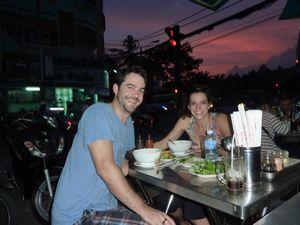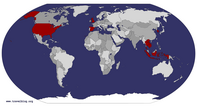Advertisement
Published: December 17th 2010

 Pho
Pho
Watching the sunset over dinnerGood Morning Vietnam!
One of the many things a traveler learns while traveling is that no matter how small our world seems, there is so much left to learn and discover. While World History is part of the curriculum in American high schools and can be taken in college, the history we learn about a country like Vietnam is generally limited to its relevance to the United States. As the Vietnam War is a significant part of history that is still intertwined in the daily lives of the Vietnamese people, the country’s heart is still beating strongly with growth and culture.
Our itinerary took us by bus from Phnom Penh, Cambodia to Ho Chi Minh City in the South of Vietnam, also known as Saigon. We traveled by bus for six hours and where we planned on staying was only a few minute walk from where the bus dropped us off in the Old Quarter of Saigon. Tucked away down an alley, our guest house felt like a home away from home. We were treated so well by the people that we felt like we had a new host family looking out for us. We dropped our bags, grabbed

 Pho
Pho
Dining on the sidewalk at our favorite Pho restaurant a map and went out to explore Ho Chi Minh City by foot.
The first three things that come to mind when talking about southern Vietnam are Pho beef noodle soup, motorcycles, and the US/Vietnam War. We have eaten at many Vietnamese restaurants in the States, especially Seattle, where they serve Pho, and admittedly, the Pho in the States is also delicious. However, eating Pho in the corner shop amongst Vietnamese people with a table full of fresh basil, cilantro, and sauces watching the traffic go by is definitely a unique experience. We ate Pho at least once if not twice a day to soak up the amazing flavor of our favorite Vietnamese cuisine.
Motorcycles are EVERYWHERE; and we thought Phnom Penh was bad. Learning to cross the street was a three step process. First, you think you can’t. Second, you run like hell when you can. Third, you do as the locals do and cross slowly. The best instructions we were given were to imagine a pedestrian as a rock and traffic like the flow of water. If you move slowly, they will go around you and you can cross any street. Unfortunately, it takes a while

 Basil
Basil
At our favorite Pho restaurant they would place this on the table along with your bowl of soup. Fresh and delicious! to get used to that mentality.
The US/Vietnam War was also all around us. The War Remnants Museum, the Reunification Palace and the Cu Chi Tunnels are three of the major tourist attractions in and around Saigon. While the night markets are more fun, the history of Vietnam’s struggle is central to understanding the people of this dynamic country.
Prior to our arrival in Vietnam, we were concerned about how we would be treated as Americans; however, the new generation seems to have moved on. Although one would think that there would be a slight animosity, we came to realize that the American War (as they call it here) is part of a bigger story.
Before Vietnam was even called Vietnam in 200 A.D., the people of the region began their resistance against Chinese rule. By the 10th century, Vietnam had gained its independence from China and began its defense against the many attacks from surrounding peoples such as the Khmers, Chams, and Mongols. From there, it was the French who came and imposed a Treaty of Protectorate on the Vietnamese in the mid to late 1800’s. The most powerful resistance to the French came from the newly

 Fruit
Fruit
at the night marketfounded communist group called the Vietnam Youth League led by Ho Chi Minh. After WWII, this group declared Vietnam independent once again under the leadership of the Viet Minh Communist party. The country was divided temporarily by the Geneva Accords into North and South; the North were communist and led by Ho Chi Minh, while the South were anticommunist and led by Ngo Dinh Diem. Diem was considered a malicious leader, thus in 1960 the Viet Minh formerly a political group became an armed guerrilla group known as the Viet Cong. Ironically, the Southern anticommunist leader Diem was eventually killed by his own troops in 1963. The North infiltrated the South in 1964 and the U.S. entered the war in 1965 to try and stop them. The United States withdrew from Vietnam in 1973, and the country reunited under communism in 1975. Repression of those who fought against the North continued for at least another decade. As we learn more and more about Vietnam, we realize that its history is long and complicated, and that our role as Americans, while important is only a fraction.
The view today in regards to war is that of education. The War Remnants

 Street Vendor
Street Vendor
on the streets of SaigonMuseum tries to teach its visitors that war is horrific and affects a country and its people long after it is over. One of the hardest parts for us to see was the exhibit about Agent Orange and how the current generation continues to suffer from its affect. The graphic photos will definitely stay with us for a long time. Visiting the Cu Chi tunnels was also fascinating. We actually crawled through a 100 meter tunnel that had been used by the Viet Cong during the war (the tunnel has been widened twice so Westerners can fit). Even the modified tunnels were dark, damp, hot and lacked oxygen. Considering that Vietnam is still called the “Socialist Republic of Vietnam”, it was no surprise that the video and information we received at the tunnels was somewhat propagandist in favor of the North Vietnamese Army. While it was slightly weird to hear things like “American Killer Hero,” it was worth it to gain a deeper understanding of the atrocities of the war. Visiting the museum, palace, and Cu Chi tunnels roused our curiosity about Vietnamese history and allowed us to appreciate what Vietnam has become today.
Vietnam wears a socialistic jacket
that appears to be bursting at the seams with capitalism, and Saigon is the tailor. The growth over the last 25 years has been astounding. We were charmed by Ho Chi Minh City’s ability to integrate its Asian personality: badminton in the park, motorcycles, pho, street markets, and pagodas, with a modern international scene: sky scrapers, museums, art galleries, coffee shops and hotels. Though we weren’t ready to leave Ho Chi Minh City, we were excited to meander through the streets of northern Vietnam’s old capital, Hanoi, and enjoy the calm of Halong Bay.
While Hanoi felt similar to Saigon in certain ways like traffic and cuisine (same same but different), it has significantly less Western influence. Continuously communist since before the war, Hanoi is much less industrialized and is smaller by both size and population. The people move at a slower pace (except the traffic) and seem to be more family oriented. Our hostel, The Drift, was in the heart of it all and provided a great refuge for the backpacker traveler. Tif, the owner/operator of the 8-story hostel provided us with everything we needed to navigate for the two days we were there. Our time in Hanoi

 The Alley
The Alley
leading to our guest housewas mainly spent exploring. As we walked, motorcycles zipped by with up to four passengers to a bike (newborns included), women vendors in cone shaped straw hats wandered the streets balancing their products in baskets, and merchants of every sort lined the sidewalks for miles on end making it nearly impossible for us to pass. Each street is defined by what is sold (ex. motor parts st., house paint st., clothing st., etc.) and the city is a labyrinth, impossible to navigate without a map, and unbelievably challenging with one. Adding to the confusion, each street changes names practically every other block with illogically ordered building numbers. Fortunately time was not of the essence, as our primary objective was nothing more than to wander, taking in the sights and smells of a truly uninfluenced Asian city.
Two days was more than enough to see what we wanted to see. The two main tourist attractions were visited in a day; Hoa Lo Prison (also known as Maison Centrale) and the Ho Chi Minh Mausoleum Complex. Hoa Lo Prison was a detention, torture, and execution center used previously by the French to imprison Vietnamese men and women who resisted colonial rule
in the early to mid 1900s. It later became home to American pilot POWs who were shot down during the Vietnam War, including former president- incumbent John McCain. Ho Chi Minh Mausoleum Complex, “the holiest of holy” for some Vietnamese, is where Ho Chi Minh’s perfectly embalmed body is left on display in a glass sarcophagus nine months a year for his followers to come and pay tribute to their former communist leader (he is shipped to Russia for 3 months a year for maintenance). Unfortunately for us, he was gone on his yearly trip to Russia when we visited.
We left the chaos and noise of Hanoi behind and made escape to the serenity of Halong Bay. A UNESCO heritage sight protected for its “its outstanding, universal aesthetic value and its outstanding geological and geomorphological value is now on the list of nominations as one the World's 7 Natural Wonders.” We boarded a traditional junk boat for a three day/two night tour. Our cruise was amazing and Halong Bay is one of our favorite places we have visited so far. The majesty of over 2,000 limestone islands, some as big as mountains and others as small as cars,
jutted out of the water as giant pillars, dripping with foliage and flocked by birds. It felt as though we had stepped into the cinematic crossover where
Avatar meets
Waterworld.
The first day was spent relaxing on board. Our junk boat (a complete misnomer) was actually quite plush and the perfect place to take in the scenery. Activities included exploring a massive limestone cave and kayaking in the emerald waters of the bay. We completed it with a full meal, and we drank into the night with the 14 other voyagers. It was great to be with such an eclectic group of people from all over the world. Day two was spent trekking around Cat Ba National Park on Cat Ba Island, the largest island in Vietnam. The highlight was summiting a ridge with an old rusty watchtower. The tower allowed for increased observation (and anxiety) of the scenery and foliage below and could be something straight out of Jurassic Park. The whole adventure was an enchanting experience!
Vietnam is a country full of wonder. From the energetic bustle and extensive history of Saigon and Hanoi to the splendor of Halong Bay and the eastern coastline (left to
be explored on another trip), Vietnam is a country that we would love to revisit.
Advertisement
Tot: 0.075s; Tpl: 0.017s; cc: 13; qc: 22; dbt: 0.0388s; 1; m:domysql w:travelblog (10.17.0.13); sld: 1;
; mem: 1.1mb























sunanda
non-member comment
Were going to jail or coming out?? Wow Saigon looks nothing like it's twin in Bocas!